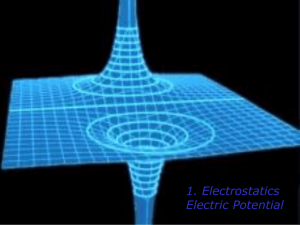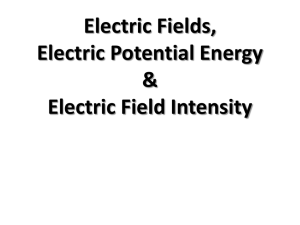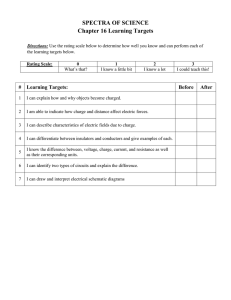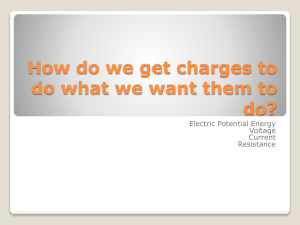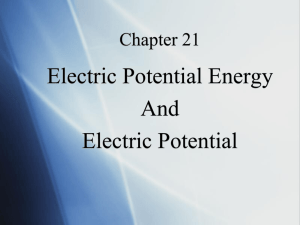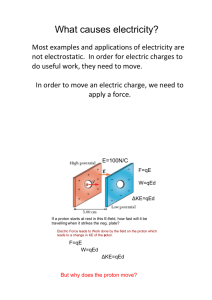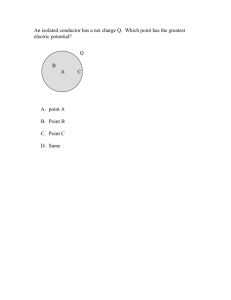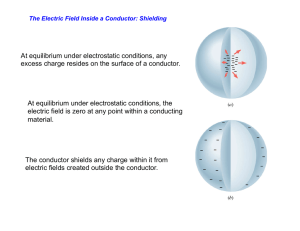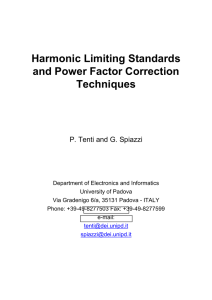Electrostatics, Electric Fields, and Electric Potential
advertisement
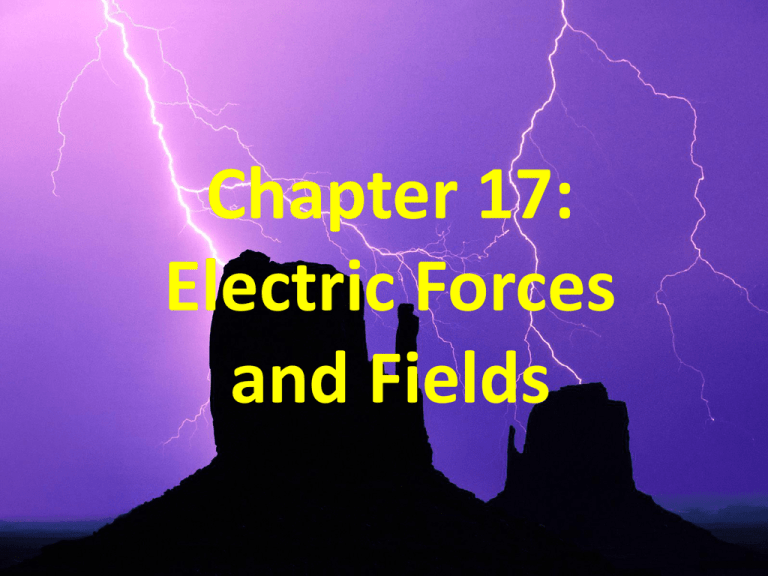
Chapter 17: Electric Forces and Fields Objectives • Understand the basic properties of electric charge. • Differentiate between conductors and insulators. • Distinguish between charging by contact, charging by induction, and charging by polarization. Electric Charge • • • • • protons have positive (+) charge electrons have negative (–) charge opposite charges attract; like charges repel charge is always conserved (cannot be destroyed) charge (q) is measured in coulombs (C) Charles Augustin Coulomb 1736 - 1806 Electric Charge is Quantized 1909: Robert Millikan qE + mg qE mg Charge on drop mg occurs in multiples q of 1.60 x 10-19 C E (±1e, ±2e, ±3e…). Transfer of Electric Charge • charges move freely through conductors (typically metals) • charges do not move freely in insulators (most other solids) Electric charge can be transferred 3 ways: • contact • induction • polarization Objectives • Calculate electric force using Coulomb’s law. • Compare electric force with gravitational force. Coulomb’s Law m1 m2 FG G r2 Law of Universal Gravitation q1 q 2 Fe k r2 Coulomb’s Law k = 8.99 x 109 Nm2/C2 Compare the gravitational and the electric forces between the proton and electron in a hydrogen atom. Objectives • Calculate electric field strength. • Draw and interpret electric field lines. • Identify the properties associated with a conductor in electrostatic equilibrium. Electric Fields Field lines show direction and strength of force (represented by the line density) • gravitational field (g) • electric field (E): (+) → (–) Fg m g g Fg m Fe q 0 E Fe E q0 units are N/C Electric Fields The nucleus applies a force of 8.16 x 10-11N on the electron in a hydrogen atom. What is the electric field strength at the position of the electron? Electric Field due to a Point Charge q q0 Fe k 2 r Fe q q0 E k 2 q0 r q0 q E k 2 r (a) What is the E-field strength at a distance of 0.45 m from a 8.2mC charge? (b) What force would be felt by a proton at this location? (c) What is the initial acceleration of the proton? Conductors in Electrostatic Equilibrium electrostatic equilibrium: no net motion of charge (a) The total electric field inside a conductor equals zero. (b) Excess charge resides on the surface. (c) E-field lines extend perpendicular to the surface. (d) Charge accumulates at points. Chapter 18: Electric Energy and Capacitance Electric Potential Energy (EPE) ME KE PE grav PEelastic PEelectric • uniform field only! • displacement in direction of the field PE grav m g h PE electric q E d g E EPE Problems • What is the change in EPE if a proton is moved 2.5mm in the direction of a uniform 7.0 x1011 N/C electric field? • What is the change in EPE if an electron is moved in the same direction? EPE for a Pair of Charges PE elec PE elec q1 q 2 q E d Fe r k r 2 r q1 q 2 k r • Two alpha particles (two helium nuclei, 2 p+ each) have an EPE of 6.32 x10-19 J. What is the distance between the two particles? Potential Difference (Voltage) PE grav m g h PE electric q E d PE grav PE electric E d q PE electric " voltage" E d q V E d (uniform field only) m gh • voltage (V) is EPE per charge • 1 volt = 1 J/C • measured with a voltmeter or multimeter • voltage is like “electric pressure” Voltage Problems What voltage exists in a 3.5 x10-6 N/C electric field between two points that are 0.25 m apart? Capacitors • Capacitors store EPE between two closely-spaced conductors that are separated by an insulator. • Capacitance is measured in farads (F). 1 F = 1 C/V Q C V PE electric 21 Q V Chapter 19: Electric Current and Electric Power Electric Current Electric charges will flow between areas of different electric potential (voltage) • electric current (I): a flow of electric charge • 1 ampere (A) = 1 C/s • measured with an ammeter • although electrons typically flow, current is defined as direction of positive flow (+ → –) • drift speed of e– in Cu at 10 A is only 0.00025 m/s • 0.005 A is painful and 0.070 A can kill you Electric Resistance • resistance (R): resistance to electron flow • measured in Ohms (Ω) • V ↑, I ↑ • R ↑, I ↓ V I R A 2400-Ω resistor is attached to a 12-V power source. What is the current through the wire? AC/DC • alternating current: electric field reverses periodically, current alternates direction (60 hz in USA) • direct current: field is constant, current is constant • batteries produce DC • electric generators can make AC or DC Electric Power and Energy Consider the units of voltage: J V C J C V J C V C V s s s W A V Pelec I V E elec I V t Power Problems If voltage = 120 V, what is the current through a 1200-W hairdryer? At $0.05 / kW·hr, how much does it cost to operate a 240-W television for 24 hrs?

